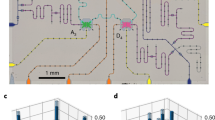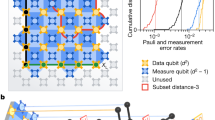Abstract
The realization of quantum error correction is an essential ingredient for reaching the full potential of fault-tolerant universal quantum computation. Using a range of different schemes, logical qubits that are resistant to errors can be redundantly encoded in a set of error-prone physical qubits. One such scalable approach is based on the surface code. Here we experimentally implement its smallest viable instance, capable of repeatedly detecting any single error using seven superconducting qubits—four data qubits and three ancilla qubits. Using high-fidelity ancilla-based stabilizer measurements, we initialize the cardinal states of the encoded logical qubit with an average logical fidelity of 96.1%. We then repeatedly check for errors using the stabilizer readout and observe that the logical quantum state is preserved with a lifetime and a coherence time longer than those of any of the constituent qubits when no errors are detected. Our demonstration of error detection with its resulting enhancement of the conditioned logical qubit coherence times is an important step, indicating a promising route towards the realization of quantum error correction in the surface code.
This is a preview of subscription content, access via your institution
Access options
Access Nature and 54 other Nature Portfolio journals
Get Nature+, our best-value online-access subscription
$29.99 / 30 days
cancel any time
Subscribe to this journal
Receive 12 print issues and online access
$209.00 per year
only $17.42 per issue
Buy this article
- Purchase on Springer Link
- Instant access to full article PDF
Prices may be subject to local taxes which are calculated during checkout





Similar content being viewed by others
Data availability
The authors declare that the data supporting the findings of this work are available online at the ETH Zurich repository for research data https://doi.org/10.3929/ethz-b-000410090.
Code availability
The codes used for experimental control are available from the corresponding author on reasonable request.
References
Zhang, J. et al. Observation of a many-body dynamical phase transition with a 53-qubit quantum simulator. Nature 551, 601–604 (2017).
Bernien, H. et al. Probing many-body dynamics on a 51-atom quantum simulator. Nature 551, 579–584 (2017).
Arute, F. et al. Quantum supremacy using a programmable superconducting processor. Nature 574, 505–510 (2019).
Preskill, J. Quantum computing in the NISQ era and beyond. Quantum 2, 79 (2018).
Cory, D. G. et al. Experimental quantum error correction. Phys. Rev. Lett. 81, 2152–2155 (1998).
Chiaverini, J. et al. Realization of quantum error correction. Nature 432, 602–605 (2004).
Schindler, P. et al. Experimental repetitive quantum error correction. Science 332, 1059–1061 (2011).
Lanyon, B. P. et al. Measurement-based quantum computation with trapped ions. Phys. Rev. Lett. 111, 210501 (2013).
Linke, N. M. et al. Fault-tolerant quantum error detection. Sci. Adv. 3, e1701074 (2017).
Yao, X.-C. et al. Experimental demonstration of topological error correction. Nature 482, 489–494 (2012).
Bell, B. A. et al. Experimental demonstration of a graph state quantum error-correction code. Nat. Commun. 5, 3658 (2014).
Cramer, J. et al. Repeated quantum error correction on a continuously encoded qubit by real-time feedback. Nat. Commun. 7, 11526 (2016).
Reed, M. D. et al. Realization of three-qubit quantum error correction with superconducting circuits. Nature 482, 382–385 (2012).
Shankar, S. et al. Autonomously stabilized entanglement between two superconducting quantum bits. Nature 504, 419–422 (2013).
Ristè, D. et al. Detecting bit-flip errors in a logical qubit using stabilizer measurements. Nat. Commun. 6, 6983 (2015).
Kelly, J. et al. State preservation by repetitive error detection in a superconducting quantum circuit. Nature 519, 66–69 (2015).
Córcoles, A. D. et al. Demonstration of a quantum error detection code using a square lattice of four superconducting qubits. Nat. Commun. 6, 6979 (2015).
Ofek, N. et al. Extending the lifetime of a quantum bit with error correction in superconducting circuits. Nature 536, 441–445 (2016).
Ristè, D. et al. Deterministic entanglement of superconducting qubits by parity measurement and feedback. Nature 502, 350–354 (2013).
Negnevitsky, V. et al. Repeated multiqubit readout and feedback with a mixed-species trapped-ion register. Nature 563, 527–531 (2018).
Andersen, C. K. et al. Entanglement stabilization using ancilla-based parity detection and real-time feedback in superconducting circuits. npj Quantum Inf. 5, 69 (2019).
Bultink, C. C. et al. Protecting quantum entanglement from leakage and qubit errors via repetitive parity measurements. Sci. Adv. 6, eaay3050 (2020).
Nigg, D. et al. Quantum computations on a topologically encoded qubit. Science 345, 302–305 (2014).
Gong, M.et al. Experimental verification of five-qubit quantum error correction with superconducting qubits. Preprint at http://arXiv.org/abs/1907.04507 (2019).
Takita, M., Cross, A. W., Córcoles, A. D., Chow, J. M. & Gambetta, J. M. Experimental demonstration of fault-tolerant state preparation with superconducting qubits. Phys. Rev. Lett. 119, 180501 (2017).
Hu, L. et al. Quantum error correction and universal gate set operation on a binomial bosonic logical qubit. Nat. Phys. 15, 503–508 (2019).
Campagne-Ibarcq, P. et al. A stabilized logical quantum bit encoded in grid states of a superconducting cavity. Preprint at http://arXiv.org/abs/1907.12487 (2019).
Kitaev, A. Y. Fault-tolerant quantum computation by anyons. Ann. Phys. (N. Y.) 303, 2–30 (2003).
Dennis, E., Kitaev, A., Landahl, A. & Preskill, J. Topological quantum memory. J. Math. Phys. 43, 4452–4505 (2002).
Raussendorf, R. & Harrington, J. Fault-tolerant quantum computation with high threshold in two dimensions. Phys. Rev. Lett. 98, 190504 (2007).
Fowler, A. G., Mariantoni, M., Martinis, J. M. & Cleland, A. N. Surface codes: towards practical large-scale quantum computation. Phys. Rev. A 86, 032324 (2012).
Lidar, D. A. & Brun, T. A. Quantum Error Correction (Cambridge Univ. Press, 2013).
Terhal, B. M. Quantum error correction for quantum memories. Rev. Mod. Phys. 87, 307–346 (2015).
Groen, J. P. et al. Partial-measurement backaction and nonclassical weak values in a superconducting circuit. Phys. Rev. Lett. 111, 090506 (2013).
Schmitt, V. et al. Multiplexed readout of transmon qubits with Josephson bifurcation amplifiers. Phys. Rev. A 90, 062333 (2014).
Jeffrey, E. et al. Fast accurate state measurement with superconducting qubits. Phys. Rev. Lett. 112, 190504 (2014).
Heinsoo, J. et al. Rapid high-fidelity multiplexed readout of superconducting qubits. Phys. Rev. Appl. 10, 034040 (2018).
Barends, R. et al. Superconducting quantum circuits at the surface code threshold for fault tolerance. Nature 508, 500–503 (2014).
Rol, M. A. et al. Fast, high-fidelity conditional-phase gate exploiting leakage interference in weakly anharmonic superconducting qubits. Phys. Rev. Lett. 123, 120502 (2019).
Versluis, R. et al. Scalable quantum circuit and control for a superconducting surface code. Phys. Rev. Appl. 8, 034021 (2017).
Johnson, J. E. et al. Heralded state preparation in a superconducting qubit. Phys. Rev. Lett. 109, 050506 (2012).
Ristè, D., van Leeuwen, J. G., Ku, H.-S., Lehnert, K. W. & DiCarlo, L. Initialization by measurement of a superconducting quantum bit circuit. Phys. Rev. Lett. 109, 050507 (2012).
Koch, J. et al. Charge-insensitive qubit design derived from the Cooper pair box. Phys. Rev. A 76, 042319 (2007).
Reed, M. D. et al. Fast reset and suppressing spontaneous emission of a superconducting qubit. Appl. Phys. Lett. 96, 203110 (2010).
Krinner, S. et al. Engineering cryogenic setups for 100-qubit scale superconducting circuit systems. Eur. Phys. J. Quantum Technol. 6, 2 (2019).
Takita, M. et al. Demonstration of weight-four parity measurements in the surface code architecture. Phys. Rev. Lett. 117, 210505 (2016).
Bacon, D. Operator quantum error-correcting subsystems for self-correcting quantum memories. Phys. Rev. A 73, 012340 (2006).
Bombin, H. & Martin-Delgado, M. A. Topological quantum distillation. Phys. Rev. Lett. 97, 180501 (2006).
Chamberland, C., Zhu, G., Yoder, T. J., Hertzberg, J. B. & Cross, A. W. Topological and subsystem codes on low-degree graphs with flag qubits. Phys. Rev. X 10, 011022 (2020).
Li, M., Miller, D., Newman, M., Wu, Y. & Brown, K. R. 2D compass codes. Phys. Rev. X 9, 021041 (2019).
Macklin, C. et al. A near-quantum-limited Josephson traveling-wave parametric amplifier. Science 350, 307–310 (2015).
Johansson, J. R., Nation, P. D. & Nori, F. QuTiP 2: a Python framework for the dynamics of open quantum systems. Comput. Phys. Commun. 184, 1234–1240 (2013).
Wiseman, H. & Milburn, G. Quantum Measurement and Control (Cambridge Univ. Press, 2010).
Acknowledgements
We are grateful for feedback from K. Brown and A. Darmawan. We acknowledge contributions to the measurement set-up from S. Storz, F. Swiadek and T. Zellweger. We acknowledge financial support by the Office of the Director of National Intelligence (ODNI), Intelligence Advanced Research Projects Activity (IARPA), via the US Army Research Office grant W911NF-16-1-0071, by the National Centre of Competence in Research Quantum Science and Technology (NCCR QSIT), a research instrument of the Swiss National Science Foundation (SNSF), by the EU Flagship on Quantum Technology H2020-FETFLAG-2018-03 project 820363 OpenSuperQ, by the SNFS R’Equip grant 206021-170731 and by ETH Zurich. The views and conclusions contained herein are those of the authors and should not be interpreted as necessarily representing the official policies or endorsements, either expressed or implied, of the ODNI, IARPA or the US Government.
Author information
Authors and Affiliations
Contributions
C.K.A. designed the device and A.R., S.K., G.J.N. and M.G fabricated the device. C.K.A., A.R., S.L. and N.L. developed the experimental control software. C.K.A., A.R., S.K. and N.L. installed the experimental set-up. C.K.A., A.R. and S.L. characterized and calibrated the device and the experimental set-up. C.K.A. carried out the main experiment and analysed the data. C.K.A. performed the numerical simulations. C.E. and A.W. supervised the work. C.K.A., A.R. and S.L. prepared the figures for the manuscript. C.K.A. wrote the manuscript with input from all coauthors.
Corresponding author
Ethics declarations
Competing interests
The authors declare no competing interests.
Additional information
Publisher’s note Springer Nature remains neutral with regard to jurisdictional claims in published maps and institutional affiliations.
Extended data
Extended Data Fig. 1 Experimental setup.
Experimental setup described in Methods.
Supplementary information
Supplementary Information
Supplementary Information.
Rights and permissions
About this article
Cite this article
Andersen, C.K., Remm, A., Lazar, S. et al. Repeated quantum error detection in a surface code. Nat. Phys. 16, 875–880 (2020). https://doi.org/10.1038/s41567-020-0920-y
Received:
Accepted:
Published:
Issue Date:
DOI: https://doi.org/10.1038/s41567-020-0920-y
This article is cited by
-
Fast joint parity measurement via collective interactions induced by stimulated emission
Nature Communications (2024)
-
Encoding a magic state with beyond break-even fidelity
Nature (2024)
-
Demonstrating multi-round subsystem quantum error correction using matching and maximum likelihood decoders
Nature Communications (2023)
-
Real-time quantum error correction beyond break-even
Nature (2023)
-
Logical qubit behavior model and fast simulation for surface code
Quantum Information Processing (2023)



